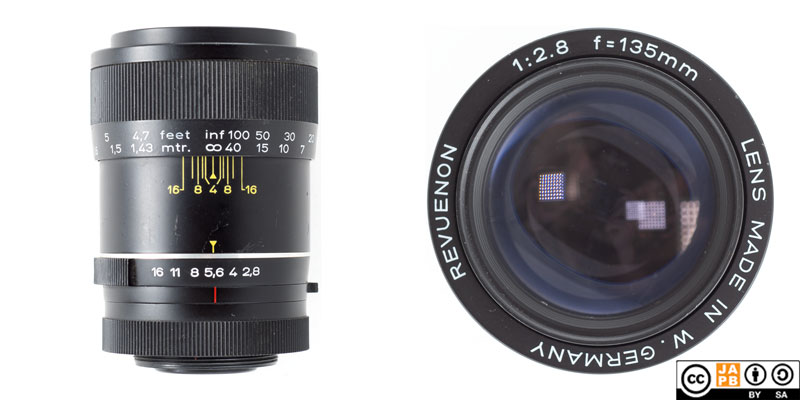Pekka Buttler, 07/2025

Specifications
The table below summarizes the lens’ key specifications (measurements based on pictured version of the lens):
| Brand: | Revuenon | Lens name | 1:2.8 f=135mm |
| Focal length(s)1 | 135 mm | Angle-of-view2 | 18 ° |
| Maximum Aperture | f/2.8 | In Production | 1970s |
| Lens mount (this lens) | M42 | Other lens mounts | – |
| Length3 | 89,8 mm | Diameter4 | 65,6 mm |
| Filter ring diameter | 52 mm | Weight | 275 grams |
| Lens element count | 5 | Lens group count | 5 |
| Aperture blades (S/R/C)5 | 7 S | Focus throw | 310 ° |
| Minimum focusing distance (measured) | 159 cms | Maximum magnification (measured) | 1:8,83 |
| Has manual aperture ring | YES | Has Manual focus ring | YES |
| Aperture mechanism type | preset | Aperture click stops | 2.8-4-5.6-8-11-16 |
Further notes:
• First off, this lens is actually an ENNA München Tele-Ennalyt 135/2.8. That same lens was sold also as the Revuenon 135/2.8 as well as the Porst Tele MC 135/2.8.
• This sample is a preset lens (in the 1970s (!)), but the same lens was also manufactured with a period-typical auto-aperture system (with A/M switch)
• The preset ring (red indicator) is activated by depressing the control tab on the lens’ side whereafter the preset can be moved. The preset will try to lock at a full stop.
• The aperture ring (yellow indicator) is clickless.
• The filter threads do not move when focusing.

Bottom: Revuenon 135/2.8 focused at MFD (it says 1,43 meters, but is actually 1,59 meters (!))
• The manufacturer ENNA München is known for three pioneering moves: They were a pioneer in developing retrofocus wide-angle lenses (see JAPB company profile on ENNA München); They were among the first companies to develop an intermediate lens mount and did so in a rather ingenious way (see the JAPB article on the ENNA Sockel); and Enna was ahead of its time in developing plastic lenses. One of these pioneering moves was not well received.
• ENNA’s interest in developing plastic housings for lenses was partially due to economic pressures, partially due to that ENNA (in other businesses) was a pioneer in injection-moulded plastics.
Versions and variations
The plastic-era ENNA/Porst/Revuenon 135 mm f/2.8 exists with some variations (beyond the branding).
Firstly, the (optically) same lens exists both as a preset aperture variant (this lens) as well as an auto aperture variant with a ring to control whether the lens is in automatic or manual mode.
Secondly, some earlier samples of the lens have a metal mount whereas most later samples have an all-plastic mount.
Adapting the Revuenon/Porst/ENNA 135 mm f/2.8
Adapting M42 mount lenses
If you want to natively mount an M42 lens you need to find a functioning M42 mount film camera. Luckily that should be relatively easy as M42 bodies were produced in their millions and most of them lack features that are especially likely to have deteriorated to the point of making the entire camera inoperable. If your sample of this lens offers a switch to choose between auto- and manual aperture, I recommend using the lens on a body that is capable of stopping down the lens automatically and offers stop-down metering.
Adapting this lens to a mirrorless, full-frame digital camera is a breeze thanks to the lens having full manual controls (aperture ring, focus ring). You simply need a dumb adapter from M42 to your mirrorless system.
Due to the medium flange focal distance used by the M42 mount (45,46 mm), whether you can adapt this lens to dSLR/SLR mounts depends on which dSLR mount: Canon EF, Four Thirds, Minolta/Sony A and Pentax K can mount m42 lenses using a simple adapter ring. Nikon F on the other hand is not as problem-free, and – to retain anything near infinity focus – the adapter will necessitate corrective optics. In all cases, your camera will work only in stop-down metering.
History of ENNA München
ENNA München (also: Enna Werk München) is one of the 1950s and 60s most prominent and innovative German optics companies. ENNA is especially well-known for being the West-German pioneer in developing retrofocus wide-angle lenses.
You can read more details in the ENNA München company profile.
History of Revue/Revuenon
See the JAPB company profile on Revue.
Footnotes
- Focal length is (unless stated otherwise) given in absolute terms, and not in Full-frame equivalent. For an understanding of whether the lens is wide/tele, see ‘Angle-of-view’. ↩︎
- Picture angle is given in degrees (based on manufacturers’ specs) and concerns the diagonal picture angle. Rule of thumb:
> 90 ° ==> Ultra-wide-angle
70–90 ° ==> Wide-angle
50–70 ° ==> Moderate wide-angle
40–50 ° ==> ‘Standard’ or ‘normal’ lens
20–40 ° ==> Short tele lens
10-20 ° ==> Tele lens
5-10 ° ==> Long tele lens
< 5 ° ==> Ultra-tele lens ↩︎ - Length is given from the mount flange to the front of lens at infinity. ↩︎
- Diameter excludes protrusions such as rabbit ears or stop-down levers. ↩︎
- S=straight; R=rounded; C=(almost)circular at all apertures. ↩︎